Unveiling América Tropical, Oct 9, 2012

A specter is haunting the City of Los Angeles – the specter of social realism in art. That spirit stalks Olvera Street, the city’s oldest boulevard; the ghostly apparition is not a lost soul from one of the original inhabitants of El Pueblo de Nuestra Señora Reina de los Ángeles (The Town of Our Lady Queen of the Angels), the name given to the small town founded in 1781 by Spanish colonists of mixed European, Native American, and African descent.
Neither is it an apparition of someone from the ancient Gabrielino-Tongva tribe, the first people to inhabit the land that eventually became L.A., though the spirit of indigenous people has much to do with this tale of a phantom returning to the world of the living. No, the phantasm I write of is América Tropical, the Olvera Street mural painted by Mexican Muralist David Alfaro Siqueiros in 1932. The wall painting’s revolutionary narrative so terrified city officials at the time that they had it whitewashed; the censored mural remained covered up for eighty years.
On Tuesday, October 9, 2012, América Tropical was unveiled in a public ceremony that I was thrilled to attend. To announce the mural’s unveiling and the simultaneous opening of the América Tropical Interpretive Center (ATIC), the Getty Conservation Institute and the City of Los Angeles held a press conference on Olvera Street at the Casa Avila Adobe, which was built in 1818 during the Spanish colonial period and today is the oldest standing building in L.A. October 9 was the fulfillment of a decades long effort to have the mural restored and presented to the public. As an artist deeply influenced by Siqueiros and his fellow Mexican Muralists, and as a member of the Board of Directors of Amigos de Siqueiros, the unveiling was a joyous occasion for me, as I have been writing about Siqueiros and his Olvera Street mural on this web log since 2005. But Oct. 9 was also a collective triumph for the hundreds of people who worked so diligently to make the dream come true.
Before inviting those gathered at the press conference to visit the rooftop mural located atop the América Tropical Interpretive Center, the Director of the Getty Conservation Institute, Timothy P. Whalen; the President and CEO of the J. Paul Getty Trust, James Cuno; Los Angeles City Councilman José Huizar, and L.A. Mayor Antonio Villaraigosa, all made poignant statements before the press about the importance of América Tropical to the people of L.A. and the world. The official 2012 unveiling of the Siqueiros mural and the opening of the interpretive center took place eighty years from the mural’s original unveiling on October 11, 1932.
The Mayor’s office and the Getty presented a commemorative plaque to Amigos de Siqueiros, for the group’s role in helping to preserve and promote América Tropical and the legacy of David Alfaro Siqueiros. The inscribed tablet was received by the Chair of Amigos de Siqueiros, Dalila Teresa Sotelo, and Carol Jacques, a commissioner for El Pueblo de Los Angeles Historical Monument and a chief liaison for Amigos de Siqueiros.
The whitewash has at last been removed from América Tropical, but it covered more than a mural painted by one of the greatest artists of the 20th century – it concealed the unvarnished truth about Los Angeles and all of the Americas. The unveiling should mark the beginning of serious dialog over the issues evident in the painting, but I hope the work also inspires a new socially engaged art for our time. That would be the real legacy of David Alfaro Siqueiros, and with the world presently in the state it is in, we should call for nothing less.
I took the following photos during the October 9, 2012, América Tropical unveiling ceremony.
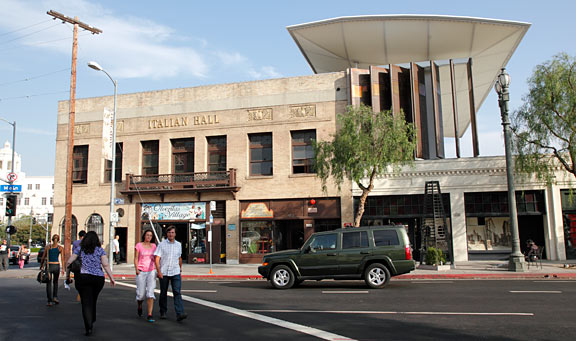 From Main Street one can partially view the América Tropical mural located on the rooftop of the historic Italian Hall. The large wing-like construction is the super-structure that protects the mural from the elements. Photograph by Mark Vallen ©.
From Main Street one can partially view the América Tropical mural located on the rooftop of the historic Italian Hall. The large wing-like construction is the super-structure that protects the mural from the elements. Photograph by Mark Vallen ©.
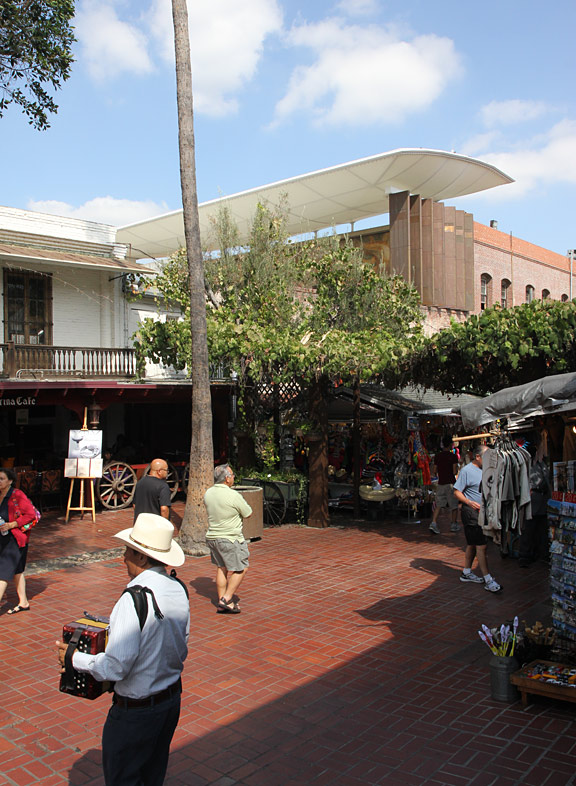 View of the mural as seen from the vender’s area of Olvera Street. To some extent one can catch a glimpse of the painting from street level, but what stands out the most is the super-structure that protects the mural from weather conditions. Photograph by Mark Vallen ©.
View of the mural as seen from the vender’s area of Olvera Street. To some extent one can catch a glimpse of the painting from street level, but what stands out the most is the super-structure that protects the mural from weather conditions. Photograph by Mark Vallen ©.
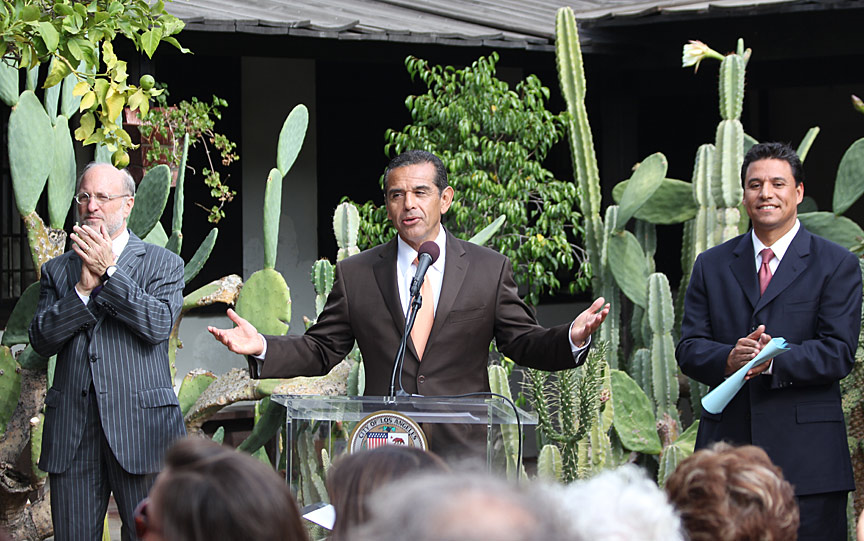 From left to right: the President and CEO of the J. Paul Getty Trust, James Cuno; Los Angeles Mayor Antonio Villaraigosa, and L.A. City Councilman José Huizar, announcing the unveiling of América Tropical at the Casa Avila Adobe October 9, 2012 press conference. Photo by Vallen ©.
From left to right: the President and CEO of the J. Paul Getty Trust, James Cuno; Los Angeles Mayor Antonio Villaraigosa, and L.A. City Councilman José Huizar, announcing the unveiling of América Tropical at the Casa Avila Adobe October 9, 2012 press conference. Photo by Vallen ©.
 Director of the Getty Conservation Institute, Timothy P. Whalen (shown at right) and L.A. Mayor Antonio Villaraigosa at the Avila Adobe press conference. Photograph by Mark Vallen ©.
Director of the Getty Conservation Institute, Timothy P. Whalen (shown at right) and L.A. Mayor Antonio Villaraigosa at the Avila Adobe press conference. Photograph by Mark Vallen ©.
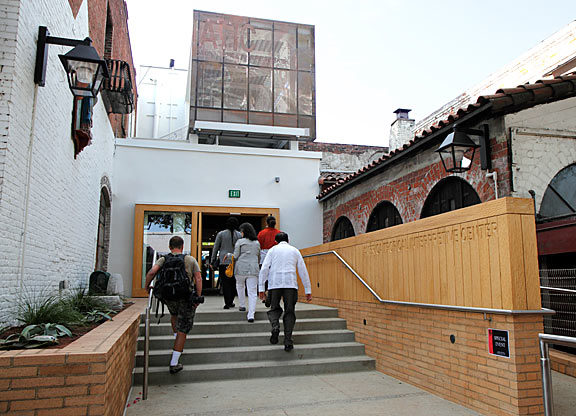 The Olvera Street entrance to the América Tropical Interpretive Center (ATIC). The box-like structure on the center’s roof is actually the observation platform where the public can view the Siqueiros mural. Photograph by Mark Vallen ©.
The Olvera Street entrance to the América Tropical Interpretive Center (ATIC). The box-like structure on the center’s roof is actually the observation platform where the public can view the Siqueiros mural. Photograph by Mark Vallen ©.
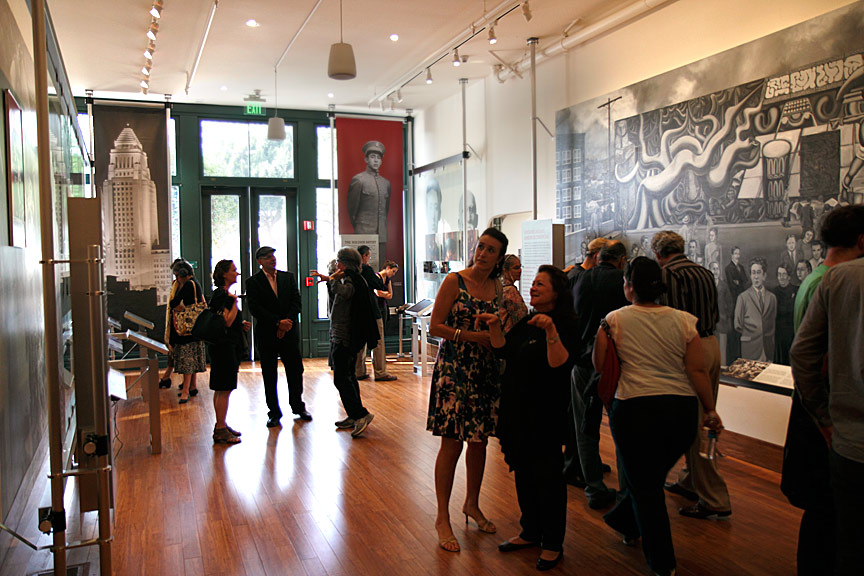 View of one of two large exhibit rooms in the América Tropical Interpretive Center. The rooms present interactive displays, photos, informative text and other ephemera related to Siqueiros and the América Tropical mural. Photograph by Mark Vallen ©.
View of one of two large exhibit rooms in the América Tropical Interpretive Center. The rooms present interactive displays, photos, informative text and other ephemera related to Siqueiros and the América Tropical mural. Photograph by Mark Vallen ©.
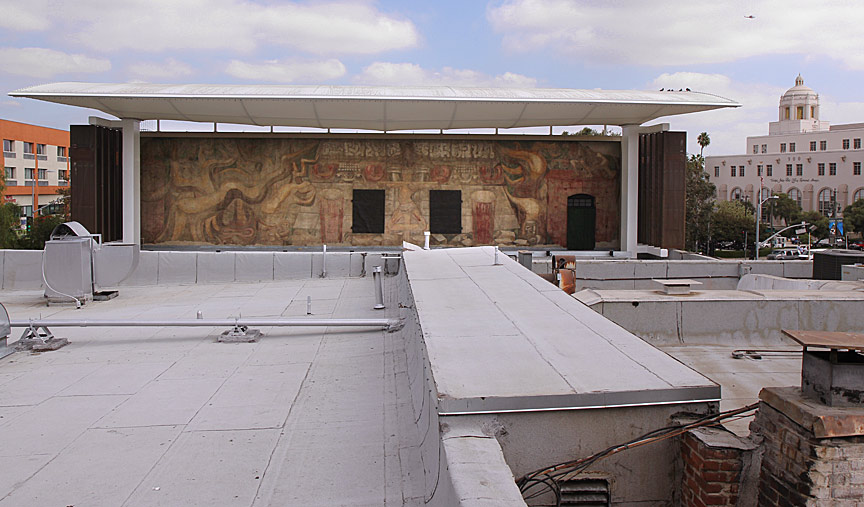 This is the view of América Tropical afforded by the observation platform atop the Interpretive Center. The mural was painted on a rooftop wall of the Italian Hall building. This photo also shows the super-structure that protects the mural. The panels on the side move to block the sun, likewise the wing-like structure above the mural can also be lowered to provide sun-shade. The domed building in the background is the Los Angeles Terminal Annex U.S. Post Office, which was built in 1939 – seven years after Siqueiros created his mural. Photograph by Mark Vallen ©.
This is the view of América Tropical afforded by the observation platform atop the Interpretive Center. The mural was painted on a rooftop wall of the Italian Hall building. This photo also shows the super-structure that protects the mural. The panels on the side move to block the sun, likewise the wing-like structure above the mural can also be lowered to provide sun-shade. The domed building in the background is the Los Angeles Terminal Annex U.S. Post Office, which was built in 1939 – seven years after Siqueiros created his mural. Photograph by Mark Vallen ©.
 This photo shows a reclining Chacmool sculptural figure Siqueiros used to represent pre-Columbian civilizations. Chacmool were common to the Toltec, Maya, and Aztec, and were utilized in religious ceremonies involving offerings and sacrifices; usually gifts to the Gods were placed on the stomach of a Chacmool figure. Pre-Columbian ruins are strewn throughout the mural, symbolizing the destruction of indigenous people by colonialism.
This photo shows a reclining Chacmool sculptural figure Siqueiros used to represent pre-Columbian civilizations. Chacmool were common to the Toltec, Maya, and Aztec, and were utilized in religious ceremonies involving offerings and sacrifices; usually gifts to the Gods were placed on the stomach of a Chacmool figure. Pre-Columbian ruins are strewn throughout the mural, symbolizing the destruction of indigenous people by colonialism.
In the above photo, along the bottom edge of the mural, one can see how the original painting suffered deterioration over the years, which presented a major challenge to Getty restorers. The staff of the Getty Conservation Institute did a world class job of preserving América Tropical, and you can read about their conservation efforts here. This photo was shot from the viewing platform using a telephoto lens. Photograph by Mark Vallen ©.
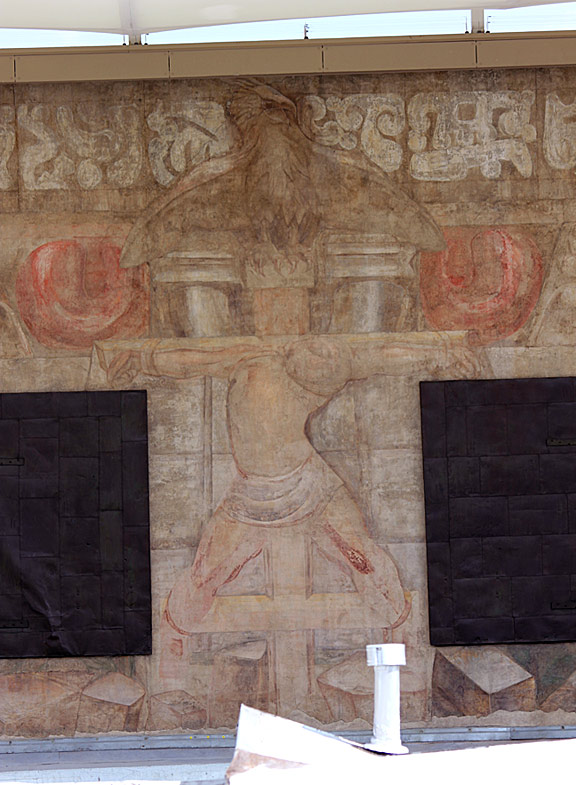 This is the thematic focus of the América Tropical mural; the eagle of imperialism sitting atop a crucifix from which hangs a murdered Indian. While the mural is a faded “ghost” image, it is remarkable how bright some of the original pigment remains. There are no known color photos of the original artwork, one of the reasons why Getty conservators decided to preserve rather than recreate the painting. A telephoto lens was used to take this photo from the viewing platform. Photograph by Mark Vallen ©.
This is the thematic focus of the América Tropical mural; the eagle of imperialism sitting atop a crucifix from which hangs a murdered Indian. While the mural is a faded “ghost” image, it is remarkable how bright some of the original pigment remains. There are no known color photos of the original artwork, one of the reasons why Getty conservators decided to preserve rather than recreate the painting. A telephoto lens was used to take this photo from the viewing platform. Photograph by Mark Vallen ©.
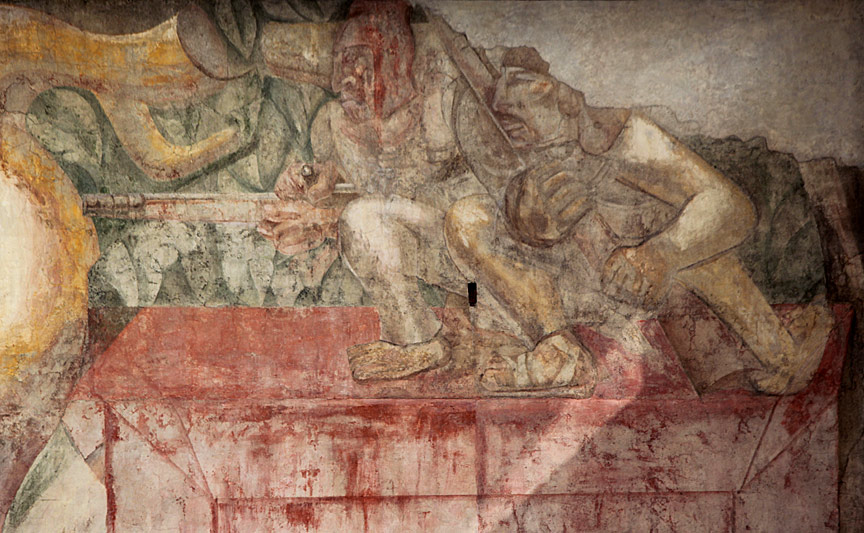 A close-up telephoto lens view of the armed revolutionaries Siqueiros painted in the upper right corner of his mural. Carrying bolt-action combat rifles of the day, the men ready an attack upon the imperialist eagle. In the upper right of the photo you can see how the mural was damaged in the 1971 Sylmar earthquake; the Getty Conservation Institute filled in the shattered area with plaster. I should also note that this is the area of the mural where the painting’s colors remain the brightest. This is most likely do to the fact that this portion of the mural could be seen from the street in 1932, and so city authorities had it whitewashed first before the rest of the mural was covered over. I took the photo from the viewing platform using a telephoto lens. Photograph by Mark Vallen ©.
A close-up telephoto lens view of the armed revolutionaries Siqueiros painted in the upper right corner of his mural. Carrying bolt-action combat rifles of the day, the men ready an attack upon the imperialist eagle. In the upper right of the photo you can see how the mural was damaged in the 1971 Sylmar earthquake; the Getty Conservation Institute filled in the shattered area with plaster. I should also note that this is the area of the mural where the painting’s colors remain the brightest. This is most likely do to the fact that this portion of the mural could be seen from the street in 1932, and so city authorities had it whitewashed first before the rest of the mural was covered over. I took the photo from the viewing platform using a telephoto lens. Photograph by Mark Vallen ©.
 A close-up telephoto lens view of the eagle in América Tropical. This war bird has a mechanized look about it, especially when considering the wings. The rapacious bird is prescient of another eagle Siqueiros would paint seven years later in his 1939 Portrait of the Bourgeoisie mural located in the stairwell of the Sindicato Mexicano de Electricistas in Mexico City. A full throttle attack against the forces of war and fascism, Portrait of the Bourgeoisie also depicted an eagle as a central design element. That metallic bird was fully mechanized and bristled with sharp knife-like edges. It sat atop a huge mechanical press that crushed humanity while spitting out gold coins. A year prior to creating the 1939 mural, Siqueiros went to Spain and joined the Republican Army in the fight against the fascist military of General Franco. Portrait of the Bourgeoisie foretold what was to befall the world with the outbreak of World War II. Photograph by Mark Vallen ©.
A close-up telephoto lens view of the eagle in América Tropical. This war bird has a mechanized look about it, especially when considering the wings. The rapacious bird is prescient of another eagle Siqueiros would paint seven years later in his 1939 Portrait of the Bourgeoisie mural located in the stairwell of the Sindicato Mexicano de Electricistas in Mexico City. A full throttle attack against the forces of war and fascism, Portrait of the Bourgeoisie also depicted an eagle as a central design element. That metallic bird was fully mechanized and bristled with sharp knife-like edges. It sat atop a huge mechanical press that crushed humanity while spitting out gold coins. A year prior to creating the 1939 mural, Siqueiros went to Spain and joined the Republican Army in the fight against the fascist military of General Franco. Portrait of the Bourgeoisie foretold what was to befall the world with the outbreak of World War II. Photograph by Mark Vallen ©.
__________________________________________________
The América Tropical Interpretive Center is now open to the public. Admission is free. The center is located on Olvera Street at: 125 Paseo de La Plaza Los Angeles, CA 90012 (click for map). The center is open Tuesday through Sunday, from 10 a.m. to 3 p.m. You can phone the center at (213) 485-6855.
Related events that I will write about in future blog posts:
A Civil Defense: Paintings of Estaño
Philip Stein, aka Estaño, was an assistant to David Alfaro Siqueiros and helped the master paint ten of his greatest works in Mexico City during a ten year period. The estate of Philip Stein is currently exhibiting paintings, drawings, and prints by Estaño at the Take My Picture Gallery in downtown L.A. This not to be missed exhibit runs until December 31, 2012.
¡América Tropical! Celebrating a Siqueiros Masterpiece – Saturday November 3, 2012.
Organized by the Getty Conservation Institute, LA Plaza de Culturas y Artes, and El Pueblo de Los Angeles Historical Monument, this festival takes place a short walking distance from the América Tropical mural and the América Tropical Interpretive Center. The festival will include Aztec Dancers, Ballet Folklorico, traditional Mariachi and authentic banda music, street theater, film, food, workshops, and even a performance by the UCLA Philharmonia Orchestra. The festival also includes observance of Día de los Muertos (Day of the Dead). A perfect day to come see the Siqueiros mural! Free admission, the fun begins and 10:30 am and goes on all day. Details and full schedule of events available here.

